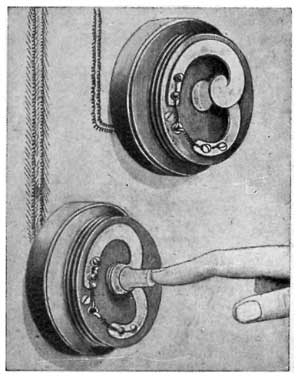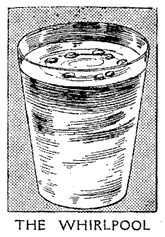A Visit to the Offices of Amateur Enterprises
by Deborah Rose
I arrive at the address in South London twenty minutes early. Normally, I wouldn’t have rung the bell right away, I’d have killed the time by peering over people’s hedges or into their windows, trying to imagine myself living their lives. (Which is normally my favourite recreation and why I became an investigative reporter in the first place). But, this is not ‘normally.’ Normally I wouldn’t have downed three cups of coffee and a glass of orange juice before leaving home an hour ago. Normally, I’m not bursting.
In a rundown suburban neighbourhood like this one, a man might discretely relieve himself against a wall or into the bushes without offending decorum overmuch. But a woman? Ha! Bursting, I ring the bell.
There’s nothing to indicate that this unprepossessing three storey building is the headquarters and main research facility of Amateur Enterprises, the organization whose website has been intriguing and baffling me for several weeks now, and whose articles I’d occasionally stumbled across long before the Internet existed – in the era, if any of you remember it, of print. Clenching, I ring again. The doorbell’s shrill signal deep in the house’s bowels is less urgent than the signal from deep in mine. For a quarter of a century, the folks at Amateur have been quietly engaged in the exploration and mapping of a territory which can be described both by what it is not: (“not science, not philosophy, not art, not literature”) – and by what it is: (here the word ‘weird’ comes to mind, and ‘preposterous’). Take, for instance, Amateur’s obsession with ‘numinous objects.’ These, the website helpfully explains, are objects ‘charged’ with sufficient ‘immanence’ to “rip a rent in the fabric of normal awareness.” A rent in the fabric of my bladder is imminent! I ring again. The Amateur website catalogues and grades the numinosity of hundreds of objects, ranging from “a yolk of leather in a tobacco egg” to, in fact, a common doorbell.

There’s nothing numinous about the bell I lean on again before, at last, the door is opened by a middle-aged lady in a lab coat. She takes one look at me and knows. “The loo? First on your left,” she says with sisterly sympathy. The word Amateur derives from amor – love. I already love my sister in the white lab coat.
There’s nothing numinous about Amateur’s toilet facilities either, though my feelings on attaining them are to my mind on a par with Sir Galahad’s on attaining the Grail. (The Holy Grail is a classic example of a ‘numinous object.’ But the Grail’s numinous charge is invested by collective faith, i.e. it’s ‘sacred.’ The folks at Amateur, the lady in the lab coat presumably among them, tend to concentrate more on secular objects. Alfred Hitchcock’s glass of milk, for instance, with the light he put in it to make it luminous. Did I tell you the folks at Amateur are weird?)

Within minutes I’m relieved, transformed, restored to normal, the imminent rent invisibly mended. While washing my hands, I resolve to keep an even firmer grip than normal on my sense of normalcy while on this assignment. I suspect that Amateur Enterprises will turn out to be a cult of mystagogues concerned exclusively with the exceptional. I’ve always been suspicious of the exceptional, perhaps because it’s a quality I spectacularly lack. Mystagogues try to bamboozle us with their tawdry ‘marvels.’ But I’ll take the everyday over the marvelous, anyday. Actually, it’s not a question of preferring one to the other, the everyday is inseparable from the marvelous. Or, as Walter Benjamin put it:
“…histrionic or fanatical stress on the mysterious side of the mysterious takes us no further; we penetrate the mystery only to the degree that we recognize it in the everyday world, by virtue of a dialectical optic that perceives the everyday as impenetrable, the impenetrable as everyday.”
Montaigne maintains that:
“Tis the taste of effeminacy that disrelishes ordinary and accustomed things.”
But the flagrantly effeminate Oscar Wilde pointed out that
“The commonest thing is delightful if one only hides it.”
And G. K. Chesterton, in an essay called The Logic of Fairyland, makes the point that:
“Fairyland is nothing but the sunny country of common sense.”
Amen to all that!
Musing thus, I flush.
The lady in the lab coat is waiting for me when I emerge.
“Call me Polly” she says when I’ve thanked her and introduced myself. It says Dr. P. Phelps on her name tag. What is she a doctor of? I ask. She’s a vet, she says, specializing in dairy animals. Aha! I say, milk! Alfred Hitchcock’s glowing glass! I read all about it in Sight and Sound! Yes, Polly says, so had she. That’s what had drawn her to Amateur in the first place, seven years ago. Polly leads me through a slightly forlorn reception area. I notice a couple of folding chairs, an unmanned desk scattered with papers, a dusty succulent, and a Mr. Coffee machine in need of cleaning. On the wall, some vaguely diploma-like documents and a group photograph dated 1977: six people standing around an excavation staring irritably at the camera as if they resented the distraction. In the corner of the room I spy a rubber ball, coloured blocks, and other evidence of child’s play. Polly confirms that the reception area is occasionally cordoned off as a crêche. No, she has no children herself. I gaze around with interest. So, these are the ‘offices of Amateur’ frequently mentioned in the articles published by the organization in their ‘sporadic fascicles .’ I’ve often imagined them, and now here I am observing them. Before long, no doubt, I’ll be remembering them. In fact, I am even now not observing them so much as imagining how I’ll remember them when the time comes. When I report this to Polly she rewards me with a warm smile.

Thus encouraged, I go on to declare that I’ve been so impressed by the Amateur articles in which these three modes of perception, Imagined, Observed, Remembered, are compared and contrasted that I often use the technique in my day-to-day life. It’s very good for killing time when arriving early for interviews, for instance, or when standing in a queue. Polly smiles on. Why, only yesterday at the post office I’d been imagining the face of the man the back of whose head I’d been observing for about a quarter of an hour. Like a speculative map of the dark side of the moon, I’d constructed a detailed mental picture of an idealized face, a face I could love, when suddenly the head turned on its neck and fixed me with a basilisk glare. It was my ex-husband! Polly laughs in a delightfully unguarded way which endears her to me even more. I tell her I adore making people laugh, but that it doesn’t happen much anymore. My husband, the current one, and I like to reminisce about the days when our children were young and our jokes were still new to them. Our little home rang with laughter. Alas, nowadays, any attempt at levity is met with scowls from the sullen teenagers we’ve somehow spawned…
Polly is still smiling, but her smile is looking a little ‘fixed’ I think, so I stop and allow her to proceed with the guided tour.
Swing doors lead to a stairwell and as Polly precedes me up she provides a commentary: “The Numinosity Research Centre has been housed in this building since 1985. On the first floor are a classroom, a library, a computer room, and a workshop where objects are designed and built. Then there’s the kiln, the cryogenic chamber, the accelerator, and the vault where objects in various states are stored.” The classroom is in use, but a sign on the door is plain: DO NOT PERTURB. The work, no doubt, of the same wag responsible for the notice on the library wall: DISQUIET. On the shelves I notice a large section devoted to poetry; a pile of yellowing copies of Popular Mechanics (an American DIY magazine from the 1950s); books by Gaston Bachelard, sets of old encyclopaedias – The Everyman (1937), the Britannica (1934), the World Book (1963)-and several of Jules Verne’s 19th century science-fantasy novels. The whole place has the shabby-genteel air of an under-funded institution offering Adult Education evening classes. This reminds me of all the resolutions I’ve made and broken to improve myself. Why is my resolve so weak? Why am I so afraid? I don’t want to be me! Suddenly I have the ominous and all-too-familiar sense that my mood is about to ‘swing.’ My depression, the ‘black dog’ which has been steadily getting blacker since my children stopped laughing at my jokes, is breathing its mephitic breath in my face. Help! Do something impulsive!
“Quick, Polly!” I blurt, “Show me something numinous!”
And she, bless her, recognizes my need just as she had earlier and rushes me along the corridor to a door marked with a black lightning bolt.

Access to the vault where the objects are stored is gained through a small changing room. First I have to don a lab coat like Polly’s and then both of us belt on waistcoats the weight of which, Polly explains, is due to their lead lining. Her voice is soothing. I find that if I concentrate on it, the self-critical hectoring in my head is muted. “We don’t know if exposure to high concentrations of numinosity is actually dangerous or not, but we don’t want to repeat the tragic mistake the Curies made with X-rays,” Polly says. She recommends that I remove my wristwatch. “People have long known that numinosity affects our subjective perception of time. Usually the experience is of time slowing down or of moments becoming ‘specious.’ But we were surprised to find that numinous objects can permanently affect the accuracy of chronometers as well.”
The watch Polly removes is a fancy-looking job with multiple buttons and dials. I decide to keep my cheap but dependable Cassio on as an experiment. We both put on clear goggles and quilted gloves like oven mitts. As Polly opens the door to the vault I make a note of the time: 9:56 exactly. I’ve forgotten myself, a wonderful liberation.
The vault I’d imagined had been a conflation of a walk-in bank vault and a decompression chamber. The vault I observe is a small domestic sauna just like the one my sister-in-law recently had installed in her basement in Basingstoke. On two tiers of cedar slats where three people could sit and sweat (four if they didn’t mind dripping on one another), two dozen dull metal boxes of various sizes are grouped together. Some no bigger than a jeweler’s ring-box. Some the size of a steamer trunk. Polly reaches for one that’s somewhere in-between, about the size of my sister-in-law’s bread-bin, and flips the catch. There’s a hissing inrush of air as the lid is lifted and the box exhales a delicious ‘odour plume,’ an olfactory ‘chord’ in which my sensitive nose detects the mingled participation of chicory, burnt sugar, talc, beeswax and freshly cut grass. I crane my neck for a glimpse but Polly blocks my view. “Shut your eyes” she says. Pleased to be teased, I comply. “Now,” Polly says, “imagine a numinous object.”
Me (sarcastically) : “Is that an order?”
Polly (sincerely) : “An invitation.”
So I try.
After concentrating for awhile, an image comes to mind, inspired by a song from my youth. I picture ‘the jar by the door’ wherein Eleanor Rigby keeps her face when she’s not wearing it. The jar’s made of unglazed grey clay, with a lid, and it looks thousands of years old, like the canopic jars in which the ancient Egyptians preserved the mummified viscera of their dead. It’s pretty spooky and I’m thinking it might well be numinous when, powerless to stop myself, I imagine it morphing into a bejeweled toilet, a conflation of the loo downstairs and my conception of the Holy Grail. I can’t suppress a giggle.
“Concentrate!” Polly admonishes, a new severity in her tone. “For this to work, you must apply yourself.”
“It’s hard,” I confess, “to take seriously.”
Polly : “Don’t despair. Join the search.”
Me : “The search?”
Polly : “The search is what everyone would undertake if they were not afraid. To be aware of the possibility of the seach is to be onto something. Not to be onto something is to be in despair.”
“I knew it!” I gasp, “Amateur Enterprises is a cult!”
“It’s a business”, she says levelly, “manufacturing. The object in this box, for instance…”
“It smells nice. Show it to me!”
“You’re not quite ready. First you have to remember a numinous object from your own experience. A memory of something you observed or imagined.”
She adds that a numinous object evoked by the written or spoken word qualifies as imagined.
I’m thinking of an appropriate response – something along the lines of “show me what’s in the box NOW, godammit!” – when I suddenly remember the stone of a slightly unusual hue which I picked up on a beach on the Suffolk coast and named Flook after a cartoon character I adored. That was the summer of 1961. I was six. I tell Polly all about it. “That stone for me was alive! I swear it had a pulse.”
Polly approves. Then she asks what I’d thought of earlier, when she’d asked me to imagine a numinous object.
I blink. I can’t think. I draw a blank. It’s gone.
She smiles. “In that case, I think you’re ready. But, before you observe it, let me tell you a little bit about this object, and about how it was manufactured, so you can imagine it specifically.” As she speaks her eyes, bright behind her goggles, close. To be cut off from her gaze like that, I don’t like it. So I close mine, too. Now we’re in sightless communion, connected by her small bold voice.
“The object you’re about to see is the translation into matter of a literary object, one invented by Gertrude Stein in her book, Tender Buttons, written in 1914. She evokes it in six words: ‘The same little sac that shines’. That’s all we had to go on. Our readers recorded high levels of numinosity on reading and re-reading those words. But could the word be made flesh? Would the numinous charge carry over from the imaginary sac verbally evoked, into a real one manufactured in our laboratory?”
I can’t help it. I burst out laughing. The spell is totally broken. “Of course it wouldn’t. It’s impossible! Ridiculous!”
Polly : “For each of us, the limits of our language define the limits of our world. At Amateur Enterprises we’re interested in exploring those limits, the drifting border where the impossible and the possible, the sublime and the ridiculous overlap.”
Me : “You can’t be serious.”
Polly : “And the serious and humorous. Our work amuses us. If it didn’t, we’d abandon it immediately. Our botched attempt to translate Emily Dickinson’s poetic image, ‘Doom’s electric moccassin’ into matter, for instance, was not without its hilarious moments.”
She closes her eyes and recovers her gravity:
“Everybody is separate, alone, enclosed in an envelope which comes between us and our desire for intimate communion with other beings and things. In the act of reading, as Marcel Proust recognized, we’re able to temporarily transcend this limitation. Phenomena evoked by words in a text are realized internally, in an act of apprehension unmediated by our limited senses.
Translating a literary object from words into matter means therefore to convert it from an unfixed entity which readily fuses with the imagination and which, crucially, adapts itself to suit each reader, into one that offers resistance. (The german word for object, gegenstand , literally means counter-stand or resistance). Given all that, how could Stein’s same little sac that shines be reified without it losing its numinous charge?
We felt we owed it to ourselves to try.”
I’m watching her, thinking how great she looks standing in her protective gear with her eyes closed in their binocular vitrine delivering herself of this strange spiel. I’m thinking it’s maybe not so strange. After all, translating a literary object into matter is only an extension or exaggeration of what a book illustrator does when translating a verbal description into a retinal image, for instance. The attendant danger of reducing the imaginative possibilities of the image by making it specific reminds me, too, of why people say they prefer radio to TV: “the pictures are so much better.” And then there’s the human tendency to value what we want more highly than what we have. The ‘ideal’ is necessarily remote, what we can’t have, which accounts for its poignancy. Attempts to materialise it are doomed. But I don’t interrupt. Instead, I close my eyes and listen to Polly describe how Stein’s little sac was materialized:
“We began by imagining the nature of the sac itself. We noted that while a sac in this context is numinous, a sack would not have been. The dictionary defines sack as ‘a large bag oblong in shape and open at one end, usu. made of coarse flax or hemp.’ But the sac we were looking for was ‘little.’ The word sac is perfumed by an etymological association with sachet – ‘a small perfumed bag, wallet, or satchel.’ But initial tests indicated that the sac was a natural one, either animal or vegetable, not man-made.
After weeks of dissecting flora and fauna we discovered that, although at this point it didn’t shine and wasn’t yet ‘the same,’ the exact sac we wanted was the amniotic sac of an armadillo.”
Deep down, I objected to the preposterousness of this, but the impulse to protest was overruled. I didn’t want to open my eyes or stop the flow of her voice, which was bigger now:
“The search led us next to the nature of its shining. As you probably know, incandescence is light produced by heat, while luminescence is ‘cold light.’ Right from the start we all agreed, whatever the source of the sac’s shine was, it was luminescent not incandescent. Somethings you just know. One day, while looking up the different categories of luminescence I came across a description of Pelagia noctiluca, a jellyfish which secretes a luminous slime. Pliny the elder was quoted as saying that ‘a staffe so rubbed or besmeared with it, may serve instead of a torch to give light before one.’
A specimen of this jellyfish was obtained from a leading bio-supplier. A thin coat of its slime was applied to the amniotic sac and, when the lights were dimmed, we saw it shine for the first time. A moving sight. But, it wasn’t like anything else in the world and, in order to be numinous, ‘the little sac that shines’ had to be ‘the same.’
So, we made a duplicate, as exactly like the first as possible. And this one was, finally, the same little sac that shines. And it was numinous.”
Her peroration at an end, Polly rewards me for my attentiveness with her wonderful smile and reaches into the box.
While attending to her I’d formed a vague mental image of the object, but when Polly holds it in her quilted mitt before my eyes I’m stunned by its sheer otherness. The sight of it gives me a somatic thrill, neither physical nor mental and yet both; my skin tingles and I feel slightly giddy with an oddly langorous excitement, as if I’m simultaneously hurtling forward at enormous velocity and standing still. (Which I suppose we all are…) My eye travels to my wrist. My cheap but dependable Cassio has stopped at 10:02. In the light of this small envelope of luciferous tissue. An object I know without doubt is charged with sufficient immanence to rip a rent in the fabric of normal awareness because it has just ripped one in mine. Polly sees it. The two of us stand there beaming at each other through our goggles. Then we fall into each others arms.
ONE MONTH LATER
As I write this, Polly sits opposite me at work on a new object. A week after my first experience I returned to the offices of Amateur Enterprises. This time to stay. My husband and kids have been very understanding. They’re sure my conversion is a temporary aberration, that I’ll soon come back to my senses, back to my home. I don’t want to disillusion them, but I am home.
St. Paul speaks of the descending fire on the road to Damascus as having killed the frivolous child in him. In a similar way, the subtle gegenschein of the numinous sac annihilated my inauthentic self. For weeks I was in an exalted state, like the pathetic child in the Kathleen Mansfield story who speaks the devastating last line in a transport of ecstasy, oblivious to her actual deprivation: “I seen the little lamp!” Sure, I’ve lost a lot – my family, my livelihood, some would say my sanity. But it was worth it to see the same little sac that shines.
The epiphany the object provoked has changed my entire orientation – philosophical, sexual, vocational. The categories of objective and subjective, reason and imagination, matter and spirit no longer impress me as mutually exclusive. Already, I’ve designed and manufactured a variant of the object Polly showed me, replacing the amniotic sac of an armadillo with the nocturnal mucous envelope secreted by the Rainbow parrotfish (Scarus guacamaia). It’s not as numinous as Polly’s, not yet. But, when I make the duplicate…
Peering over people’s hedges or into their windows, trying to imagine myself living their lives didn’t give me half the buzz that I get from designing and manufacturing numinous objects. I’d recommend Amateur Enterprises to anybody looking for a pleasant way to kill the time, before time returns the favour.
No longer afraid, I have joined the search.